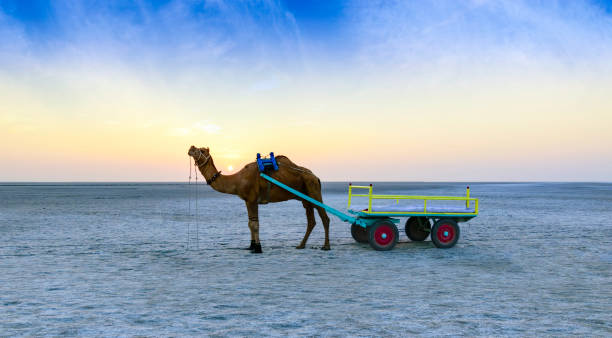Table of Contents
Introduction
The Enigmatic Beauty of the Rann of Kutch, a vast salt marsh in India, holds a unique charm that has captivated explorers and travelers for centuries. Stretching across the border of Gujarat and Pakistan’s Sindh province, this otherworldly landscape is a tapestry of contrasts, from blinding white salt flats to vibrant wildlife and ancient traditions. In this article, we delve into the enigmatic beauty of the Rann of Kutch, uncovering its wonders and mysteries that continue to bewitch those who venture into its embrace.
The Mesmerizing White Desert
At first glance, the Rann of Kutch appears as an endless expanse of pristine white. This salt desert is the largest of its kind in the world, covering an area of over 10,000 square miles. During the monsoon season, the desert transforms into a shallow wetland, only to revert to its salt-encrusted state as the water evaporates. The blinding white landscape is a photographer’s dream, offering surreal backdrops for stunning visuals that seem to transcend reality.
A Play of Light and Shadows:Enigmatic Beauty of the Rann of Kutch
As the sun traverses the sky, the Rann of Kutch becomes a canvas for nature’s artistry. The interplay of light and shadows casts intricate patterns on the salt crust, creating an ethereal spectacle. At sunset, the desert is bathed in hues of gold and pink, turning the barren land into a realm of enchantment.
The Kutchi Culture and Traditions
Beyond its physical allure, the Rann of Kutch is steeped in the rich cultural tapestry of the Kutchi people. Indigenous tribes like the Rabari and Ahir have called this region home for generations. Their vibrant clothing, intricate embroidery, and traditional mud houses known as bhungas are a testament to their unique way of life.
The Rann Utsav: A Celebration of Life
One of the most anticipated events in the region is the Rann Utsav, a three-month-long carnival that showcases the essence of Kutchi culture. This grand festival is a melange of folk dances, music, artisanal crafts, and sumptuous local cuisine. Tourists from around the world gather to witness the cultural extravaganza that breathes life into the arid landscape.(Enigmatic Beauty of the Rann of Kutch)
Unveiling the Geological Enigma:Enigmatic Beauty of the Rann of Kutch
Beneath its shimmering surface, the Rann of Kutch harbors geological mysteries that continue to baffle scientists. The land’s elevation is below sea level, making it one of the lowest points in India. This, combined with seismic activity, has led to the creation of “mud volcanoes” – cone-like formations that spew mud instead of lava. These natural phenomena offer a glimpse into the complex forces that shape our planet.
The Great Rann’s Fossilized Secrets:Enigmatic Beauty of the Rann of Kutch
Embedded within the salt layers of the Rann are fossilized remnants of prehistoric marine life. These relics serve as a window into a time when the region was submerged under the Arabian Sea. The discovery of ancient marine creatures in an otherworldly desert serves as a reminder of Earth’s ever-changing history.
Conservation Efforts and Challenges
While the Rann of Kutch is undeniably captivating, it faces environmental challenges that threaten its delicate balance. The extraction of salt, increasing tourism footprints, and changing weather patterns pose a risk to the ecosystem’s sustainability. Efforts are being made to raise awareness and implement conservation measures to preserve this natural wonder for future generations.
Conclusion
The Enigmatic Beauty of the Rann of Kutch is a paradoxical marvel that defies conventional definitions of beauty. Its desolate expanse holds stories of ancient civilizations, geological marvels, and living traditions. As travelers venture into its enigmatic embrace, they are greeted with a sensory overload that awakens a deep connection with the natural world. The Rann of Kutch is more than a destination; it’s a journey into the heart of wonder and mystery.
FAQs
1. Can I visit the Rann of Kutch year-round?
Certainly! The Enigmatic Beauty of the Rann of Kutch is a destination that you can visit throughout the year. However, it’s important to note that the experience and landscape can vary depending on the season. Let’s take a closer look at what each season offers:
- Winter (November to February): This is considered the best time to visit the Rann of Kutch. The weather is pleasant and cool, making it ideal for exploration. During this season, the Rann Utsav takes place, attracting a multitude of tourists. The Rann looks stunning under the soft winter sunlight, and you can also witness the mesmerizing sight of migratory birds.
- Summer (March to June): The summer months in the Rann of Kutch can be quite hot, with temperatures soaring during the day. While this might not be the most comfortable time to visit, it’s relatively less crowded, offering a unique experience for travelers who can brave the heat. The vast white desert can be blindingly bright under the strong sun.
- Monsoon (July to September): The monsoon brings a different charm to the Rann. The salt desert transforms into a shallow wetland, attracting a variety of birds and creating a unique ecosystem. However, access to certain areas might be restricted due to water accumulation.
- Post-Monsoon (October): After the monsoon season, the Rann starts to dry up, gradually returning to its salt-encrusted state. This can be an interesting time to visit as you can witness the transition from wetland to desert.
2. Are there accommodations available for tourists?
Yes, during the Rann Utsav, temporary accommodations are set up to cater to tourists.
3. How do I reach the Rann of Kutch?
Bhuj has the closest airport and train station. From there, you can hire a taxi or take a bus to reach the Rann.
4. Is the salt extraction damaging the ecosystem?
Excessive salt extraction can have negative impacts. Sustainable practices are being encouraged to mitigate this.
5. What is the best time to witness the mud volcanoes?
The mud volcanoes are active throughout the year, but the winter months provide the most comfortable weather for exploration.
